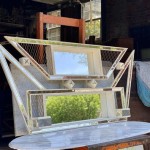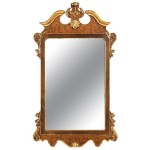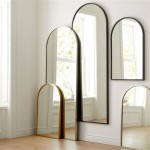How To Hang A Frameless Mirror On The Wall
Hanging a frameless mirror can significantly enhance the aesthetic of any room, providing a sleek and modern look without the visual bulk of a traditional frame. However, the absence of a frame necessitates a different approach compared to hanging framed artwork or traditional mirrors. The process demands careful planning, precise execution, and the use of appropriate materials to ensure the mirror is securely mounted and remains undamaged. This article will provide a comprehensive guide on how to hang a frameless mirror effectively and safely.
Planning and Preparation: Gathering Materials and Choosing the Right Location
Before initiating the installation process, thorough planning and preparation are crucial. This involves selecting the appropriate location for the mirror, gathering the necessary tools and materials, and taking accurate measurements. The location should be chosen based on aesthetic considerations, practical needs (e.g., in a bathroom or dressing room), and structural factors like the presence of wall studs.
The first step is to identify the desired location for the mirror. Consider the size and shape of the mirror in relation to the wall space. Ensure there is ample clearance around the mirror to prevent accidental bumps or collisions. Also, assess the lighting conditions in the area, as the mirror's reflective properties can significantly impact the room's overall brightness.
Once the location is determined, gather the following materials and tools:
*Frameless Mirror: Ensure the mirror is in perfect condition, free from cracks or chips. Note its dimensions and weight, as this will influence the choice of hanging hardware.
*Mounting Hardware: This is a critical component. Options include mirror clips, adhesive pads, or specialized mirror mounting brackets. Mirror clips are a reliable and versatile choice, providing mechanical support. Adhesive pads offer a more discreet solution but are generally suitable for smaller, lighter mirrors. Mirror mounting brackets are designed for heavier mirrors and offer enhanced stability.
*Level: A spirit level is essential for ensuring the mirror is hung straight.
*Measuring Tape: Accurate measurements are crucial for precise placement.
*Pencil: Used for marking the wall for drilling or adhesive placement.
*Drill (with appropriate drill bits): If using mirror clips or brackets, a drill is necessary for creating pilot holes in the wall.
*Screws (appropriate for wall type): Select screws that are suitable for the wall material (e.g., drywall anchors for drywall, masonry screws for brick or concrete).
*Stud Finder: A stud finder helps locate wall studs, providing a more secure anchor point for heavier mirrors.
*Safety Glasses: Protects eyes from debris during drilling.
*Gloves: Protects hands and ensures a better grip during installation.
*Clean Cloth: For cleaning the mirror surface and the wall.
After gathering the necessary materials, carefully measure the dimensions of the mirror. Use the measuring tape to determine the desired height and center point on the wall. Mark these points lightly with a pencil. If using mirror clips, measure the distance between the mounting holes on the clips and transfer these measurements to the wall, ensuring they are level. For adhesive pads, mark the locations where the pads will be applied.
Before proceeding with the installation, clean the back of the mirror and the wall surface where the adhesive or mounting hardware will be applied. This ensures proper adhesion and prevents dust or dirt from compromising the bond.
Installation Techniques: Utilizing Different Mounting Methods
There are several methods for hanging a frameless mirror, each with its own advantages and disadvantages. The choice of method depends on the size and weight of the mirror, the type of wall, and the desired aesthetic.
Mirror Clips: Mirror clips are a popular and reliable option for hanging frameless mirrors. They provide mechanical support and are relatively easy to install. There are two primary types of mirror clips: edge clips and bottom clips. Edge clips are typically used in pairs, one at the top and one at the bottom of the mirror. Bottom clips provide support from underneath and are often used in conjunction with a top clip to secure the mirror in place.
To install mirror clips, first determine the placement of the clips on the wall. Use the measurements taken during the planning phase to mark the locations for the mounting holes. Use a stud finder to determine if any of the marked locations align with wall studs. If possible, mounting the clips directly into studs provides the most secure hold.
If studs are not available, use appropriate wall anchors for drywall or masonry screws for brick or concrete. Drill pilot holes at the marked locations, ensuring the holes are the correct size for the selected anchors or screws. Insert the anchors into the holes and then attach the mirror clips using the screws. Ensure the clips are securely fastened to the wall, but avoid over-tightening, which could damage the wall or the clips.
Once the clips are installed, carefully slide the mirror into place. The clips should hold the mirror securely, preventing it from slipping or falling. Check the level of the mirror using a spirit level and make any necessary adjustments by slightly loosening or tightening the screws on the clips.
Adhesive Pads: Adhesive pads offer a more discreet mounting solution, as they are virtually invisible once the mirror is installed. However, they are generally suitable for smaller, lighter mirrors, as their weight-bearing capacity is limited. It is essential to use adhesive pads specifically designed for mirrors to ensure a strong and durable bond.
To install adhesive pads, clean the back of the mirror and the wall surface thoroughly. Remove the protective backing from the adhesive pads and carefully apply them to the back of the mirror, spacing them evenly across the surface. Press the pads firmly onto the mirror to ensure a strong bond.
Align the mirror with the marked location on the wall and press it firmly into place. Apply even pressure across the entire surface of the mirror for several minutes to ensure the adhesive pads make good contact with the wall. It is generally recommended to use a support brace or tape to hold the mirror in place for at least 24 hours while the adhesive fully cures.
Mirror Mounting Brackets: Mirror mounting brackets are designed for heavier mirrors and offer enhanced stability and security. These brackets typically consist of two parts: a bracket that attaches to the wall and a corresponding bracket that attaches to the back of the mirror. The two brackets interlock to securely hold the mirror in place.
To install mirror mounting brackets, first attach the brackets to the back of the mirror. Use a strong adhesive specifically designed for mirrors or screws, depending on the design of the brackets. Ensure the brackets are securely attached to the mirror, following the manufacturer's instructions.
Next, attach the corresponding brackets to the wall, aligning them with the brackets on the mirror. Use a stud finder to locate wall studs and, if possible, mount the brackets directly into the studs for maximum support. If studs are not available, use appropriate wall anchors for drywall or masonry screws for brick or concrete.
Once both sets of brackets are securely installed, carefully lift the mirror and interlock the brackets. Ensure the mirror is securely held in place by the brackets and check the level using a spirit level. Make any necessary adjustments by slightly adjusting the position of the brackets on the wall.
Safety Considerations and Troubleshooting
During the installation process, safety should be a primary concern. Always wear safety glasses to protect your eyes from debris while drilling. Wear gloves to protect your hands and ensure a better grip on the tools and the mirror.
When drilling into walls, be aware of the location of electrical wiring and plumbing. Use a wire and pipe locator to avoid accidentally drilling into live wires or water pipes. If you are unsure about the location of these services, consult a qualified electrician or plumber.
When handling the mirror, be extremely careful to avoid dropping or damaging it. Frameless mirrors are particularly vulnerable to damage along the edges, so handle them with care and avoid bumping them against hard surfaces.
If you encounter any problems during the installation process, such as difficulty drilling into the wall or the mirror not sitting level, do not force the issue. Instead, consult a professional installer for assistance. Attempting to force the installation could result in damage to the mirror, the wall, or yourself.
If using adhesive pads, ensure the wall surface is clean and free from dust, grease, or other contaminants. This will ensure a strong bond between the adhesive pads and the wall. Avoid using adhesive pads in areas with high humidity or temperature fluctuations, as these conditions can weaken the adhesive over time.
If using mirror clips, ensure the clips are properly aligned and securely fastened to the wall. Over-tightening the screws can damage the wall or the clips, while under-tightening can result in the mirror slipping or falling. Check the level of the mirror regularly and make any necessary adjustments.
For heavier mirrors, it is essential to use appropriate mounting hardware and to secure the mirror to wall studs whenever possible. Using wall anchors alone may not provide sufficient support for heavier mirrors, and the mirror could eventually pull away from the wall. If you are unsure about the weight-bearing capacity of the wall, consult a professional installer for advice.
After the mirror is installed, inspect it carefully for any signs of damage or instability. Check the level of the mirror and make any necessary adjustments. Clean the surface of the mirror with a glass cleaner to remove any fingerprints or smudges. Periodically inspect the mounting hardware to ensure it remains secure and that the mirror is stable.
By following these guidelines, hanging a frameless mirror can be a straightforward and rewarding project, enhancing the aesthetic of any room with a sleek and modern touch.

How To Install A Mirror Without Frame Merrypad

How To Hang A Frameless Mirror On Wall

How To Hang A Frameless Mirror On The Wall With Pictures

How To Hang A Frameless Mirror On The Wall With Pictures

How To Install A Mirror Without Frame Merrypad
:strip_icc()/DesireeBurnsInteriors1-f76d25cad90041c88fbae4a7dc10aab4.jpg?strip=all)
2 Simple Ways To Hang A Frameless Mirror

How To Hang A Frameless Mirror June 2024 Your Guide Hanging

Oval Frameless Wall Mirror Installation Fab Glass And

Mirror Installation Without Clips

How To Hang A Hanging Mirror Without Accompanying Hardware








